Functionalization of Silica SBA-15 with [3-(2-Aminoethylamino)Propyl] Trimethoxysilane in Supercritical CO2 Modified with Methanol or Ethanol for Carbon Capture
Abstract
1. Introduction
2. Materials and Methods
2.1. Materials
2.2. Functionalization of Silica SBA-15 with AEAPTS in scCO2 Modified with ca. 10% Mol Alcohol
2.3. Conventional Functionalization of Silica SBA-15 with AEAPTS in Toluene
2.4. Material Characterization
2.5. Excess Carbon Dioxide Adsorption
3. Results
3.1. Functionalization of Silica SBA-15 with AEAPTS
3.2. Excess Carbon Dioxide Adsorption
4. Discussion
4.1. Functionalization of Silica SBA-15 with AEAPTS
4.2. Excess CO2 Adsorption
5. Conclusions
Author Contributions
Funding
Acknowledgments
Conflicts of Interest
References
- OECD. Towards Green Growth? OECD Publishing: Paris, France, 2015. [Google Scholar] [CrossRef]
- United Nations. COP21 Paris Agreement; United Nations Framework Convention on Climate Change: Paris, France, 2016. [Google Scholar]
- Bui, M.; Adjiman, C.S.; Bardow, A.; Anthony, E.J.; Boston, A.; Brown, S.; Fennell, P.S.; Fuss, S.; Galindo, A.; Hackett, L.A.; et al. Carbon capture and storage (CCS): The way forward. Energy Environ. Sci. 2018, 11, 1062–1176. [Google Scholar] [CrossRef]
- Boot-Handford, M.E.; Abanades, J.C.; Anthony, E.J.; Blunt, M.J.; Brandani, S.; Mac Dowell, N.; Fernández, J.R.; Ferrari, M.-C.; Gross, R.; Hallett, J.P.; et al. Carbon capture and storage update. Energy Environ. Sci. 2014, 7, 130–189. [Google Scholar] [CrossRef]
- Choi, S.; Drese, J.H.; Jones, C.W. Adsorbent Materials for Carbon Dioxide Capture from Large Anthropogenic Point Sources. ChemSusChem 2009, 2, 796–854. [Google Scholar] [CrossRef]
- Goel, C.; Kaur, H.; Bhunia, H.; Bajpai, P.K. Carbon dioxide adsorption on nitrogen enriched carbon adsorbents: Experimental, kinetics, isothermal and thermodynamic studies. J. CO2 Util. 2016, 16, 50–63. [Google Scholar] [CrossRef]
- Rogacka, J.; Seremak, A.; Luna-Triguero, A.; Formalik, F.; Matito-Martos, I.; Firlej, L.; Calero, S.; Kuchta, B. High-throughput screening of metal – Organic frameworks for CO2 and CH4 separation in the presence of water. Chem. Eng. J. 2021, 403, 126392. [Google Scholar] [CrossRef]
- Dou, B.; Wang, C.; Song, Y.; Chen, H.; Jiang, B.; Yang, M.; Xu, Y. Solid sorbents for in-situ CO2 removal during sorption-enhanced steam reforming process: A review. Renew. Sust. Energ. Rev. 2016, 53, 536–546. [Google Scholar] [CrossRef]
- Hu, X.; Liu, L.; Luo, X.; Xiao, G.; Shiko, E.; Zhang, R.; Fan, X.; Zhou, Y.; Liu, Y.; Zeng, Z.; et al. A review of N-functionalized solid adsorbents for post-combustion CO2 capture. Appl. Energy 2020, 260, 114244. [Google Scholar] [CrossRef]
- Zhang, S.; Chen, C.; Ahn, W.-S. Recent progress on CO2 capture using amine-functionalized silica. Curr. Opin. Green Sustain. Chem. 2019, 16, 26–32. [Google Scholar] [CrossRef]
- Sanz-Pérez, E.S.; Murdock, C.R.; Didas, S.A.; Jones, C.W. Direct Capture of CO2 from Ambient Air. Chem. Rev. 2016, 116, 11840–11876. [Google Scholar] [CrossRef]
- Wurzbacher, J.A.; Gebald, C.; Steinfeld, A. Separation of CO2 from air by temperature-vacuum swing adsorption using diamine-functionalized silica gel. Energy Environ. Sci. 2011, 4, 3584–3592. [Google Scholar] [CrossRef]
- Krishnamurthy, S.; Lind, A.; Bouzga, A.; Pierchala, J.; Blom, R. Post combustion carbon capture with supported amine sorbents: From adsorbent characterization to process simulation and optimization. Chem. Eng. J. 2021, 406, 127121. [Google Scholar] [CrossRef]
- Stevens, L.; Williams, K.; Han, W.Y.; Drage, T.; Snape, C.; Wood, J.; Wang, J. Preparation and CO2 adsorption of diamine modified montmorillonite via exfoliation grafting route. Chem. Eng. J. 2013, 215, 699–708. [Google Scholar] [CrossRef]
- Raganati, F.; Chirone, R.; Ammendola, P. CO2 Capture by Temperature Swing Adsorption: Working Capacity As Affected by Temperature and CO2 Partial Pressure. Ind. Eng. Chem. Res. 2020, 59, 3593–3605. [Google Scholar] [CrossRef]
- Brinker, C.J.; Scherer, G.W. CHAPTER 10—Surface Chemistry and Chemical Modification. In Sol-Gel Science; Brinker, C.J., Scherer, G.W., Eds.; Academic Press: San Diego, CA, USA, 1990; pp. 616–672. [Google Scholar]
- Chen, C.; Zhang, S.; Row, K.H.; Ahn, W.-S. Amine–silica composites for CO2 capture: A short review. J. Energy Chem. 2017, 26, 868–880. [Google Scholar] [CrossRef]
- Sánchez-Vicente, Y.; Stevens, L.A.; Pando, C.; Torralvo, M.J.; Snape, C.E.; Drage, T.C.; Cabañas, A. A new sustainable route in supercritical CO2 to functionalize silica SBA-15 with 3-aminopropyltrimethoxysilane as material for carbon capture. Chem. Eng. J. 2015, 264, 886–898. [Google Scholar] [CrossRef]
- Sánchez-Vicente, Y.; Pando, C.; Cortijo, M.; Cabañas, A. Chemical surface modification of mesoporous silica SBA-15 with a tertiary aminosilane using supercritical carbon dioxide. Microporous Mesoporous Mater. 2014, 193, 145–153. [Google Scholar] [CrossRef]
- Zemanian, T.S.; Fryxell, G.E.; Liu, J.; Mattigod, S.; Franz, J.A.; Nie, Z. Deposition of Self-Assembled Monolayers in Mesoporous Silica from Supercritical Fluids. Langmuir 2001, 17, 8172–8177. [Google Scholar] [CrossRef]
- Cao, C.; Fadeev, A.Y.; McCarthy, T.J. Reactions of Organosilanes with Silica Surfaces in Carbon Dioxide. Langmuir 2001, 17, 757–761. [Google Scholar] [CrossRef]
- Zhang, X.; Heinonen, S.; Levänen, E. Applications of supercritical carbon dioxide in materials processing and synthesis. RSC Adv. 2014, 4, 61137–61152. [Google Scholar] [CrossRef]
- López-Aranguren, P.; Fraile, J.; Vega, L.F.; Domingo, C. Regenerable solid CO2 sorbents prepared by supercritical grafting of aminoalkoxysilane into low-cost mesoporous silica. J. Supercrit. Fluids 2014, 85, 68–80. [Google Scholar] [CrossRef]
- Sánchez-Vicente, Y.; Alonso-Pastor, O.; Pando, C.; Cabañas, A. Phase behaviour of the two binary systems formed by CO2 and the silane precursors N-[3-(trimethoxysilyl)propyl]aniline or (3-mercaptopropyl)trimethoxysilane. J. Chem. Thermodyn. 2016, 103, 152–156. [Google Scholar] [CrossRef]
- Tenorio, M.J.; Cabañas, A.; Pando, C.; Renuncio, J.A.R. Solubility of Pd(hfac)2 and Ni(hfac)2·2H2O in supercritical carbon dioxide pure and modified with ethanol. J. Supercrit. Fluids 2012, 70, 106–111. [Google Scholar] [CrossRef]
- Jessop, P.G.; Subramaniam, B. Gas-Expanded Liquids. Chem. Rev. 2007, 107, 2666–2694. [Google Scholar] [CrossRef]
- Zhao, D.; Huo, Q.; Feng, J.; Chmelka, B.F.; Stucky, G.D. Nonionic Triblock and Star Diblock Copolymer and Oligomeric Surfactant Syntheses of Highly Ordered, Hydrothermally Stable, Mesoporous Silica Structures. J. Am. Chem. Soc. 1998, 120, 6024–6036. [Google Scholar] [CrossRef]
- Shenderovich, I.G.; Buntkowsky, G.; Schreiber, A.; Gedat, E.; Sharif, S.; Albrecht, J.; Golubev, N.S.; Findenegg, G.H.; Limbach, H.-H. Pyridine-15N A Mobile NMR Sensor for Surface Acidity and Surface Defects of Mesoporous Silica. J. Phys. Chem. B 2003, 107, 11924–11939. [Google Scholar] [CrossRef]
- Zheng, F.; Tran, D.N.; Busche, B.J.; Fryxell, G.E.; Addleman, R.S.; Zemanian, T.S.; Aardahl, C.L. Ethylenediamine-Modified SBA-15 as Regenerable CO2 Sorbent. Ind. Eng. Chem. Res. 2005, 44, 3099–3105. [Google Scholar] [CrossRef]
- Rouquerol, J.; Rouquerol, F.; Llewellyn, P.; Maurin, G.; Sing, K.S.W. Adsorption by Powders and Porous Solids: Principles, Methodology and Applications; Academic Press: San Diego, CA, USA, 2013. [Google Scholar]
- Mafra, L.; Čendak, T.; Schneider, S.; Wiper, P.V.; Pires, J.; Gomes, J.R.B.; Pinto, M.L. Structure of Chemisorbed CO2 Species in Amine-Functionalized Mesoporous Silicas Studied by Solid-State NMR and Computer Modeling. J. Am. Chem. Soc. 2017, 139, 389–408. [Google Scholar] [CrossRef]
- Mafra, L.; Čendak, T.; Schneider, S.; Wiper, P.V.; Pires, J.; Gomes, J.R.B.; Pinto, M.L. Amine functionalized porous silica for CO2/CH4 separation by adsorption: Which amine and why. Chem. Eng. J. 2018, 336, 612–621. [Google Scholar] [CrossRef]
- Knöfel, C.; Descarpentries, J.; Benzaouia, A.; Zeleňák, V.; Mornet, S.; Llewellyn, P.L.; Hornebecq, V. Functionalised micro-/mesoporous silica for the adsorption of carbon dioxide. Microporous Mesoporous Mater. 2007, 99, 79–85. [Google Scholar] [CrossRef]
- Yeo, S.-D.; Park, S.-J.; Kim, J.-W.; Kim, J.-C. Critical Properties of Carbon Dioxide + Methanol, + Ethanol, + 1-Propanol, and + 1-Butanol. J. Chem. Eng. Data 2000, 45, 932–935. [Google Scholar] [CrossRef]
- Lim, J.S.; Lee, Y.Y.; Chun, H.S. Phase equilibria for carbon dioxide-ethanol-water system at elevated pressures. J. Supercrit. Fluids 1994, 7, 219–230. [Google Scholar] [CrossRef]
- Joung, S.N.; Yoo, C.W.; Shin, H.Y.; Kim, S.Y.; Yoo, K.-P.; Lee, C.S.; Huh, W.S. Measurements and correlation of high-pressure VLE of binary CO2–alcohol systems (methanol, ethanol, 2-methoxyethanol and 2-ethoxyethanol). Fluid Phase Equilib. 2001, 185, 219–230. [Google Scholar] [CrossRef]
- Matthias, T.; Katsumi, K.; Alexander, V.N.; James, P.O.; Francisco, R.-R.; Jean, R.; Kenneth, S.W.S. Physisorption of gases, with special reference to the evaluation of surface area and pore size distribution (IUPAC Technical Report). Pure Appl. Chem. 2015, 87, 1051–1069. [Google Scholar] [CrossRef]
- Meynen, V.; Cool, P.; Vansant, E.F. Synthesis of siliceous materials with micro- and mesoporosity. Microporous Mesoporous Mater. 2007, 104, 26–38. [Google Scholar] [CrossRef]
- Hiyoshi, N.; Yogo, K.; Yashima, T. Adsorption characteristics of carbon dioxide on organically functionalized SBA-15. Microporous Mesoporous Mater. 2005, 84, 357–365. [Google Scholar] [CrossRef]
- Dibenedetto, A.; Aresta, M.; Fragale, C.; Narracci, M. Reaction of silylalkylmono- and silylalkyldi-amines with carbon dioxide: Evidence of formation of inter- and intra-molecular ammonium carbamates and their conversion into organic carbamates of industrial interest under carbon dioxide catalysis. Green Chem. 2002, 4, 439–443. [Google Scholar] [CrossRef]
- Bresciani, G.; Biancalana, L.; Pampaloni, G.; Marchetti, F. Recent Advances in the Chemistry of Metal Carbamates. Molecules 2020, 25, 3603. [Google Scholar]
- Wang, X.; Conway, W.; Lawrance, G.; Burns, R.; Puxty, G.; Maeder, M. Kinetics of the Reversible Reaction of CO2(aq) with Ammonia in Aqueous Solution. J. Phys. Chem. A 2011, 115, 6405–6412. [Google Scholar] [CrossRef]
- Asefa, T.; Tao, Z. Mesoporous silica and organosilica materials—Review of their synthesis and organic functionalization. Can. J. Chem. 2012, 90, 1015–1031. [Google Scholar] [CrossRef]
- Haensch, C.; Hoeppener, S.; Schubert, U.S. Chemical modification of self-assembled silane based monolayers by surface reactions. Chem. Soc. Rev. 2010, 39, 2323–2334. [Google Scholar] [CrossRef]
- Fadeev, A.Y.; McCarthy, T.J. Self-Assembly Is Not the Only Reaction Possible between Alkyltrichlorosilanes and Surfaces: Monomolecular and Oligomeric Covalently Attached Layers of Dichloro- and Trichloroalkylsilanes on Silicon. Langmuir 2000, 16, 7268–7274. [Google Scholar] [CrossRef]
- Tenorio, M.J.; Morère, J.; Carnerero, C.; Torralvo, M.J.; Pando, C.; Cabañas, A. Thiol group functionalization of mesoporous SiO2 SBA-15 using supercritical CO2. Microporous Mesoporous Mater. 2018, 256, 147–154. [Google Scholar] [CrossRef]
- Wei, J.; Shi, J.; Pan, H.; Zhao, W.; Ye, Q.; Shi, Y. Adsorption of carbon dioxide on organically functionalized SBA-16. Microporous Mesoporous Mater. 2008, 116, 394–399. [Google Scholar] [CrossRef]
- Masuda, K.; Ito, Y.; Horiguchi, M.; Fujita, H. Studies on the solvent dependence of the carbamic acid formation from ω-(1-naphthyl)alkylamines and carbon dioxide. Tetrahedron 2005, 61, 213–229. [Google Scholar] [CrossRef]
- McKittrick, M.W.; Jones, C.W. Toward single-site functional materials—Preparation of amine-functionalized surfaces exhibiting site-isolated behavior. Chem. Mater. 2003, 15, 1132–1139. [Google Scholar] [CrossRef]
- Norihito, H.; Katsunori, Y.; Tatsuaki, Y. Adsorption of Carbon Dioxide on Amine Modified SBA-15 in the Presence of Water Vapor. Chem. Lett. 2004, 33, 510–511. [Google Scholar] [CrossRef]
- Khatri, R.A.; Chuang, S.S.C.; Soong, Y.; Gray, M. Carbon Dioxide Capture by Diamine-Grafted SBA-15: A Combined Fourier Transform Infrared and Mass Spectrometry Study. Ind. Eng. Chem. Res. 2005, 44, 3702–3708. [Google Scholar] [CrossRef]
- Raganati, F.; Chirone, R.; Ammendola, P. Effect of Temperature on Fluidization of Geldart’s Group A and C Powders: Role of Interparticle Forces. Ind. Eng. Chem. Res. 2017, 56, 12811–12821. [Google Scholar] [CrossRef]
- Ge, K.; Yu, Q.; Chen, S.; Shi, X.; Wang, J. Modeling CO2 adsorption dynamics within solid amine sorbent based on the fundamental diffusion-reaction processes. Chem. Eng. J. 2019, 364, 328–339. [Google Scholar] [CrossRef]
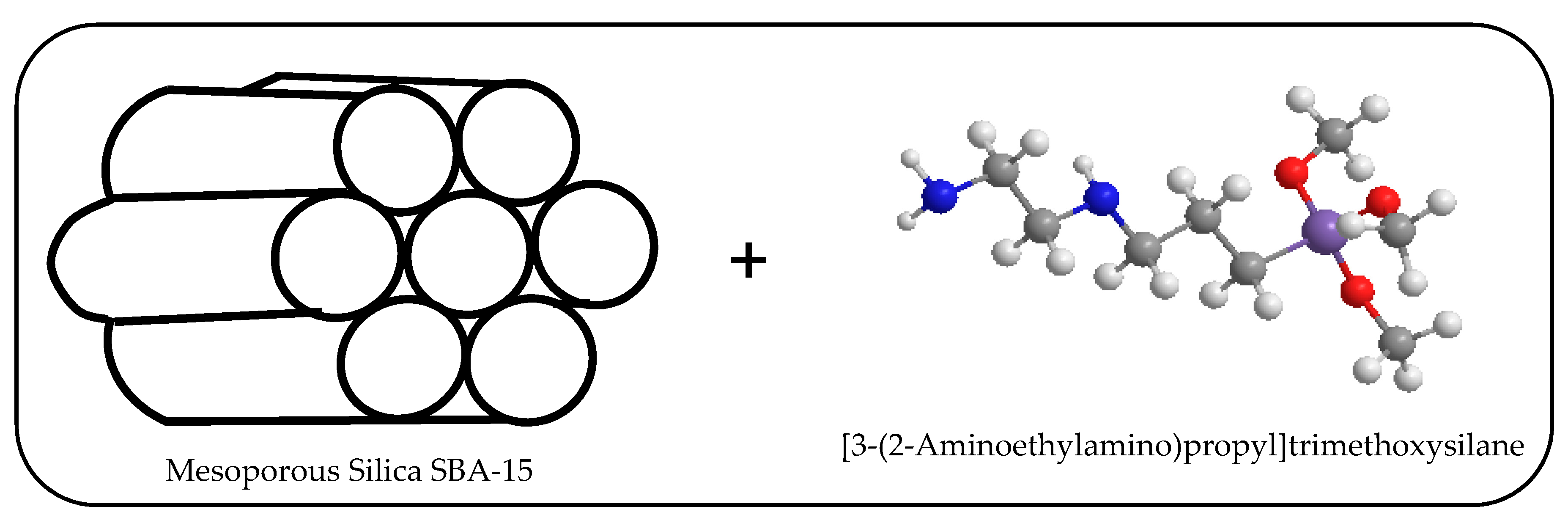

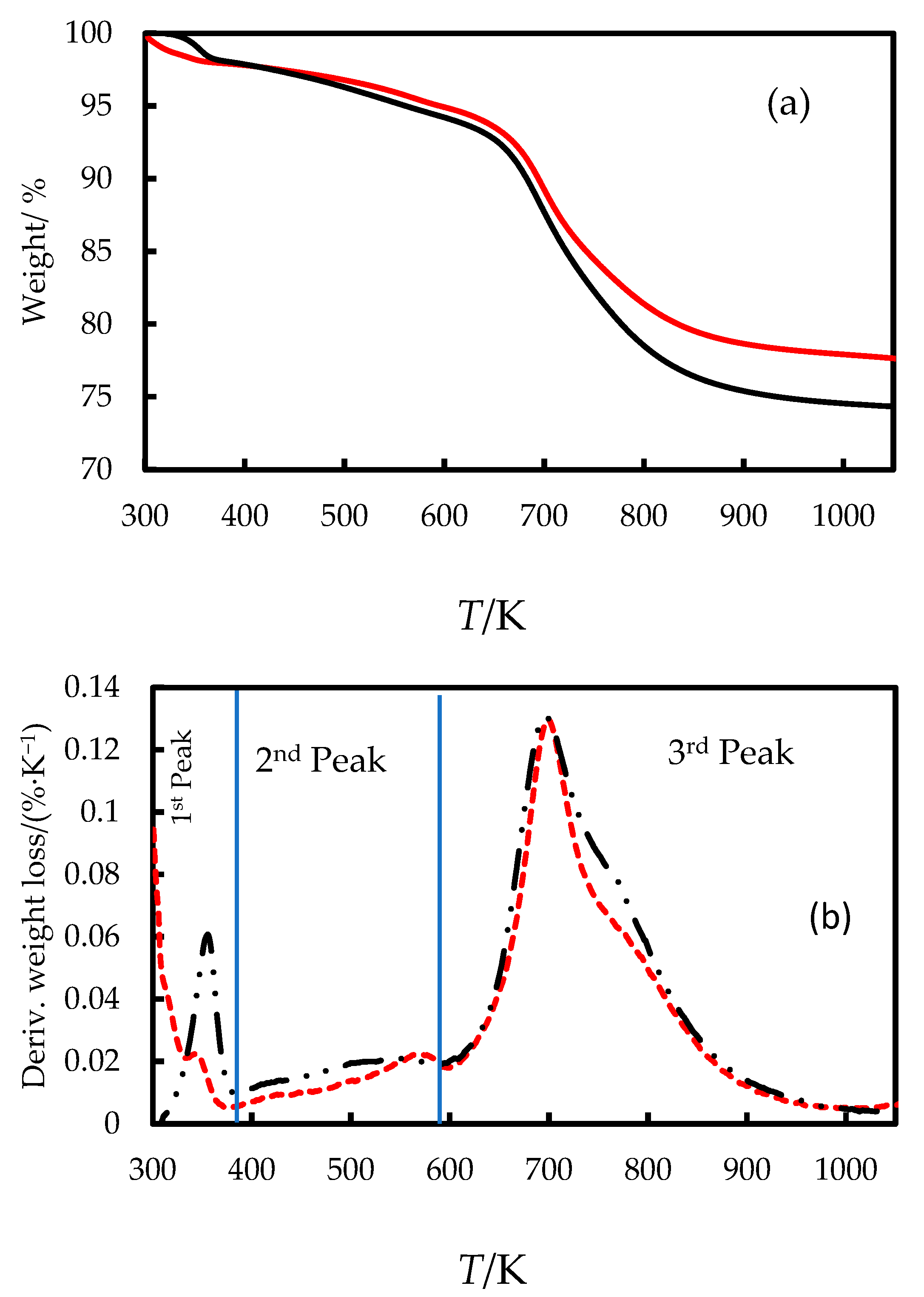
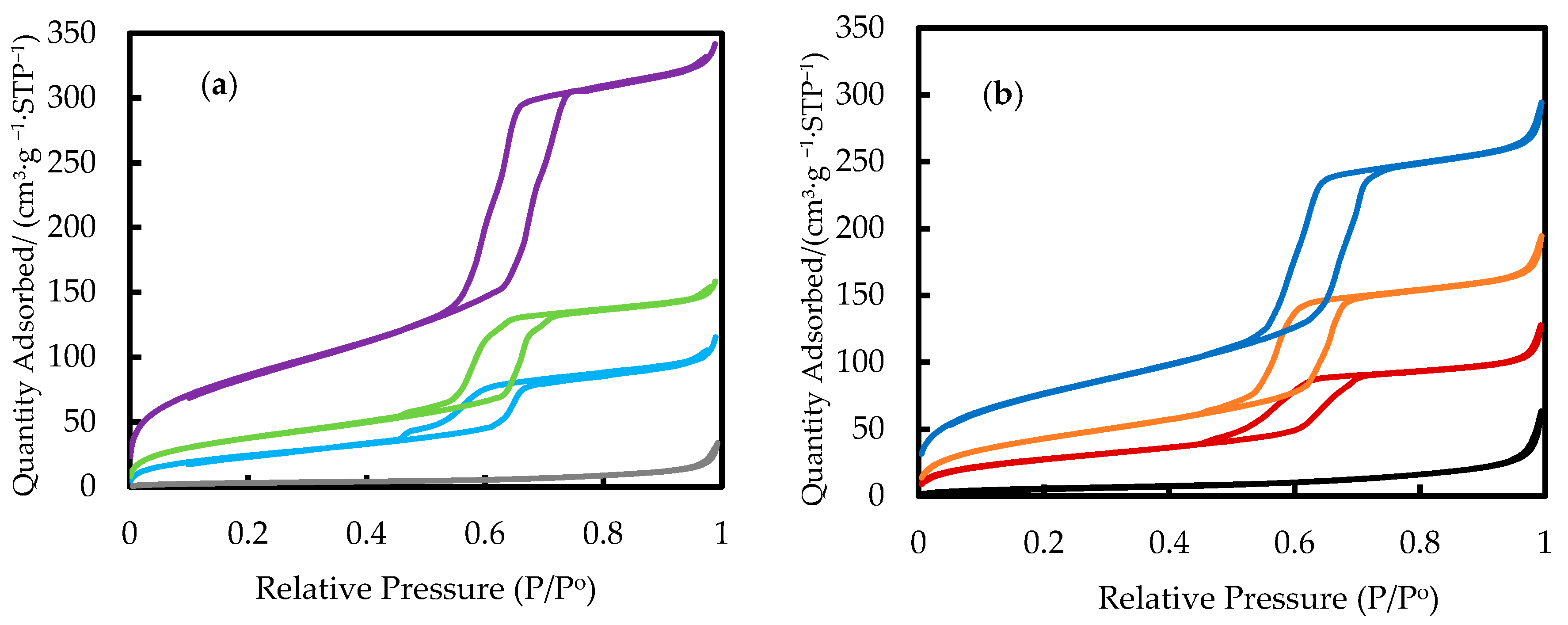
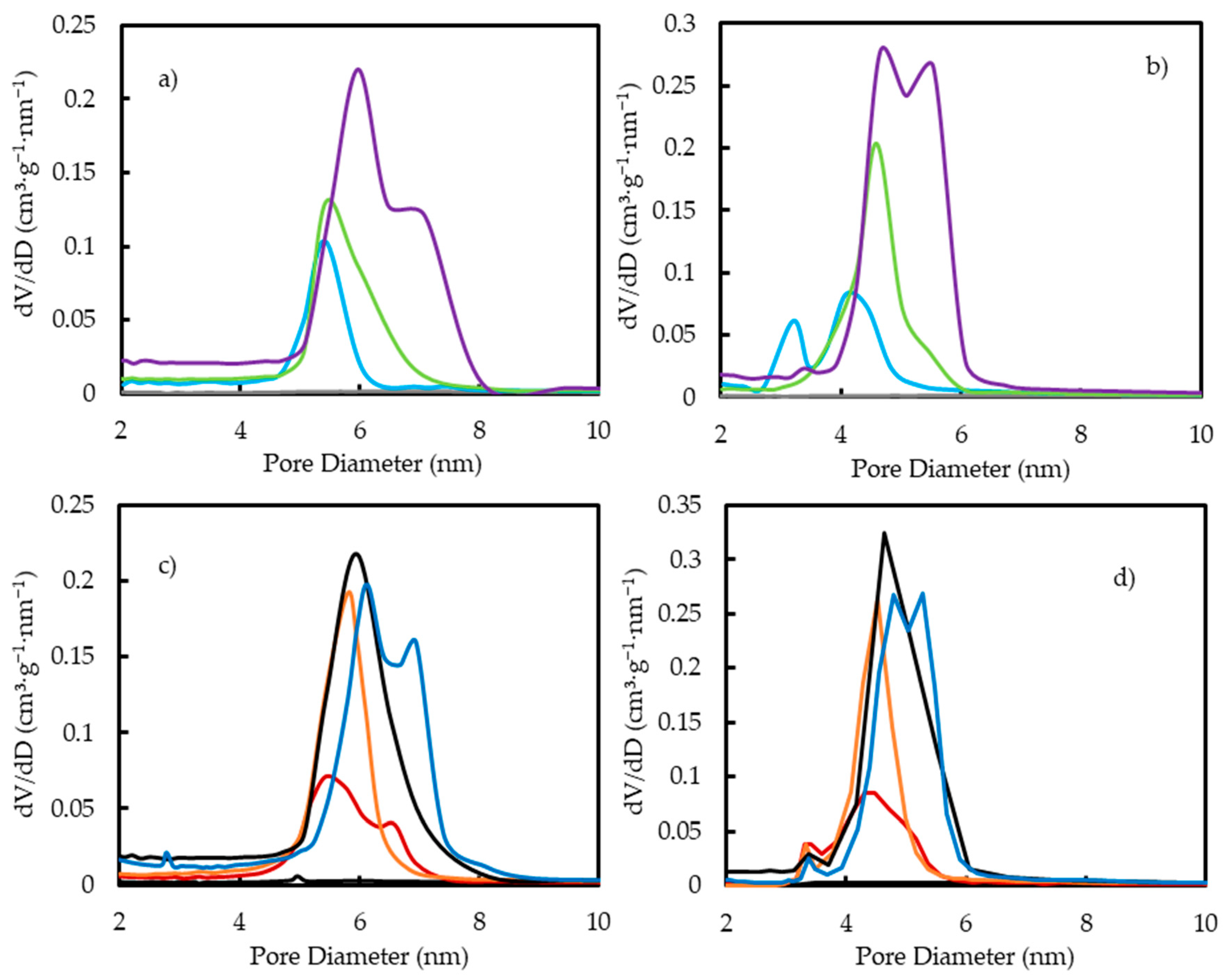
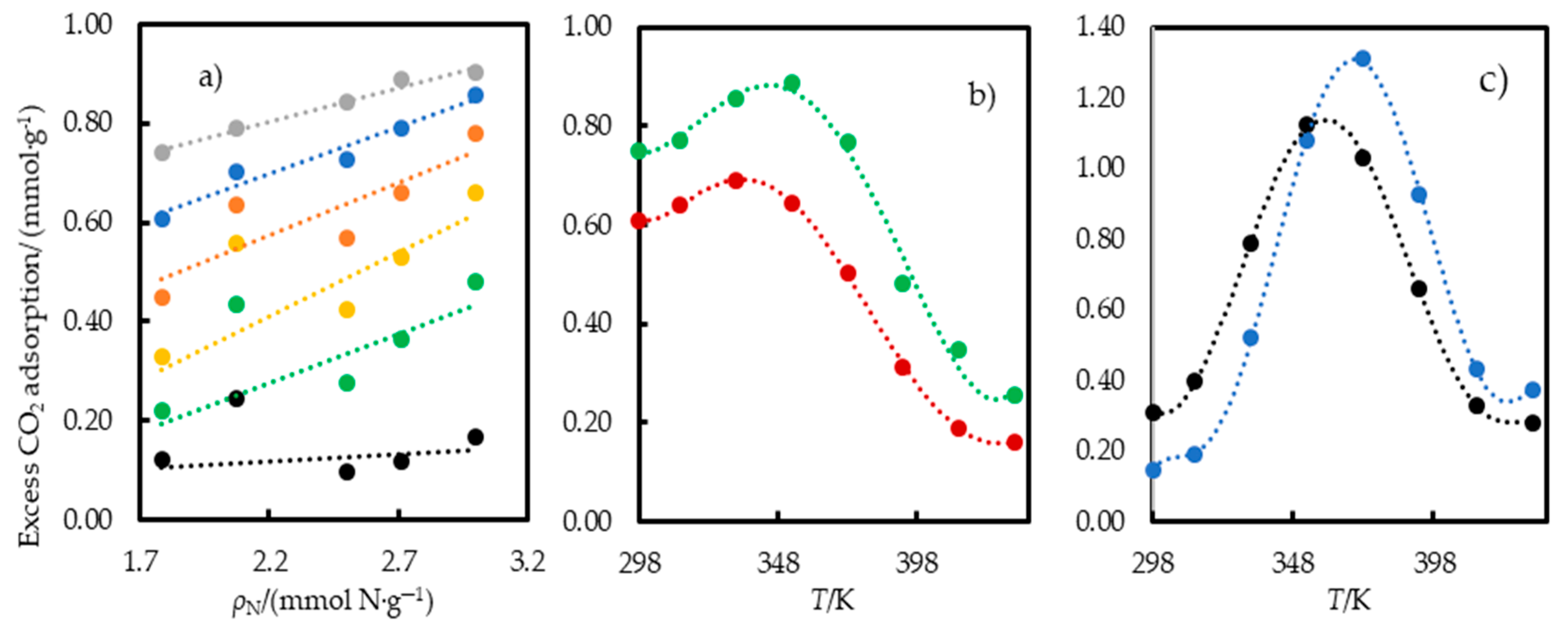

| 1 Sample | 2y∙10−3 | p/MPa | Time/Hour | TGA (% Mass) | 3ρm (mmol∙g−1) | 4ρS (Molec∙nm−2) | ||
|---|---|---|---|---|---|---|---|---|
| 301 to 383 K | 383 to 598 K | 598 to 1073 K | ||||||
| scCO2 modified with 10% mol methanol | ||||||||
| A1 | 0.6 | 12.5 | 2 | 1.2 | 4.3 | 7.8 | 0.8 | 0.8 |
| A2 | 1.0 | 12.4 | 2 | 0.1 | 2.9 | 13.7 | 1.6 | 1.6 |
| A3 | 1.7 | 12.7 | 3 | 2.5 | 3.0 | 17.4 | 2.1 | 2.1 |
| scCO2 modified with 10% mol ethanol | ||||||||
| A4 | 0.5 | 12.5 | 3 | 0.4 | 2.9 | 11.1 | 1.2 | 1.3 |
| A5 | 1.0 | 12.5 | 2 | 2.5 | 2.8 | 11.2 | 1.2 | 1.3 |
| A6 | 1.1 | 12.5 | 3 | 12.8 | 1.4 | 1.5 | ||
| A7 | 1.8 | 12.5 | 3 | 2.1 | 2.9 | 17.3 | 2.1 | 2.1 |
| Toluene | ||||||||
| C1 | 14.1 | 0.1 | 24 | 2.7 | 4.7 | 21.8 | 2.8 | 2.8 |
| C2 | 6.0 | 0.1 | 24 | 1.9 | 3.7 | 19.4 | 2.4 | 2.4 |
| 1 Sample | Elemental Analysis | SBET (m2∙g−1) | Vp (cm3∙g−1) | Pore Size (nm) | ||||
|---|---|---|---|---|---|---|---|---|
| C/% | H/% | N/% | C, H, N/% | C: N | ||||
| SBA-15 | 590 | 0.81 | 7.1 | |||||
| scCO2 modified with 10% mol methanol | ||||||||
| A1 | 6.2 | 1.4 | 2.5 | 10 | 2.9 | 319 | 0.50 | 6.0 |
| A2 | 9.1 | 2.0 | 3.8 | 15 | 2.8 | 141 | 0.22 | 5.4 |
| A3 | 12.4 | 2.9 | 5.3 | 21 | 2.7 | 92 | 0.15 | 5.4 |
| scCO2 modified with 10% mol ethanol | ||||||||
| A4 | 7.6 | 1.7 | 2.9 | 12 | 3.1 | 281 | 0.40 | 6.1 |
| A5 | 8.2 | 1.8 | 3.5 | 14 | 2.7 | 267 | 0.42 | 5.9 |
| A6 | 9.7 | 2.2 | 4.2 | 16 | 2.7 | 161 | 0.25 | 5.8 |
| A7 | 12.5 | 2.4 | 4.5 | 19 | 3.2 | 103 | 0.15 | 5.4 |
| Toluene | ||||||||
| C1 | 16.8 | 3.4 | 7 | 27 | 2.8 | 11 | 0.02 | - |
| C2 | 14.7 | 3.1 | 6.2 | 24 | 2.8 | 22 | 0.04 | - |
| System | x | T/K | p/MPa | Transition | Reference |
|---|---|---|---|---|---|
| CO2 + methanol | 0.106 | 313 | 8.1 | Bp | [34] |
| 0.106 | 323 | 9.6 | Bp | [34] | |
| 0.106 | 333 | 11.1 | Dp | [34] | |
| CO2 + ethanol | 0.105 | 313 | 7.9 | Bp | [35] |
| 0.101 | 323 | 9.1 | Bp | [36] | |
| 0.098 | 333 | 10.5 | Dp | [35] |
| Sample Name 1 | ρN (mmol N∙g−1) | Excess CO2 Adsorption (mmol∙g−1) | Amine Efficiency (mol CO2∙mol−1 N) | ||||||||
|---|---|---|---|---|---|---|---|---|---|---|---|
| T/K | T/K | ||||||||||
| 298 | 313 | 333 | 353 | 373 | 393 | 413 | 433 | 298 | 333 | ||
| SBA-15 | 0.0 | 0.60 | 0.40 | 0.23 | 0.14 | 0.08 | 0.04 | 0.01 | 0.00 | ||
| scCO2 modified with 10% mol methanol | |||||||||||
| A1 | 1.8 | 0.74 | 0.61 | 0.45 | 0.33 | 0.22 | 0.13 | 0.15 | 0.12 | 0.41 | 0.25 |
| A2 | 2.7 | 0.89 | 0.79 | 0.66 | 0.53 | 0.36 | 0.18 | 0.18 | 0.12 | 0.33 | 0.24 |
| A3 | 3.8 | 0.75 | 0.77 | 0.86 | 0.89 | 0.77 | 0.48 | 0.35 | 0.26 | 0.20 | 0.23 |
| scCO2 modified with 10% mol ethanol | |||||||||||
| A4 | 2.1 | 0.79 | 0.70 | 0.64 | 0.56 | 0.43 | 0.30 | 0.20 | 0.24 | 0.38 | 0.31 |
| A5 | 2.5 | 0.84 | 0.73 | 0.57 | 0.42 | 0.28 | 0.13 | 0.15 | 0.10 | 0.34 | 0.23 |
| A6 | 3.0 | 0.90 | 0.86 | 0.78 | 0.66 | 0.48 | 0.26 | 0.24 | 0.17 | 0.30 | 0.26 |
| A7 | 3.2 | 0.61 | 0.64 | 0.69 | 0.64 | 0.50 | 0.31 | 0.19 | 0.16 | 0.19 | 0.22 |
| Toluene | |||||||||||
| C1 | 5.0 | 0.15 | 0.19 | 0.52 | 1.08 | 1.31 | 0.93 | 0.43 | 0.37 | 0.03 | 0.10 |
| C2 | 4.4 | 0.31 | 0.39 | 0.79 | 1.12 | 1.03 | 0.66 | 0.33 | 0.28 | 0.07 | 0.18 |
| Support/Agent | ρN/(mmol N∙g−1) | Adsorption Condition | CO2 Adsorption (mmol∙g−1) | Amine Efficiency (mol CO2∙mol−1 N) | Ref. | |
|---|---|---|---|---|---|---|
| pCO2/kPa | T/K | |||||
| SBA-15/AEAPTS | 3.9 | 100 | 298 | 1.40 | 0.38 | [32] |
| SBA-16/AEAPTS | 7.7 | 100 | 300 | 0.80 | 0.10 | [33] |
| SBA-16/AEAPTS | 2.1-2.6 | 15 | 333 | 0.30 -0.60 | 0.14-0.29 | [47] |
| SBA-15/AEAPTS | 4.2 | 15 | 333 | 0.87 | 0.21 | [50] |
| SBA-15/AEAPTS | 4.6 | 100 | 292 | 1.95 | 0.42 | [29] |
| SBA-15/AEAPTS | 2.3 | 15 | 333 | 0.26 | 0.11 | [39] |
| 3.8 | 15 | 333 | 0.87 | 0.23 | [39] | |
| SBA-15/3APTS 1 | 2.5-3.0 | 100 | 298 | 1.00-1.46 | 0.49-0.40 | [18] |
Publisher’s Note: MDPI stays neutral with regard to jurisdictional claims in published maps and institutional affiliations. |
© 2020 by the authors. Licensee MDPI, Basel, Switzerland. This article is an open access article distributed under the terms and conditions of the Creative Commons Attribution (CC BY) license (http://creativecommons.org/licenses/by/4.0/).
Share and Cite
Sánchez-Vicente, Y.; Stevens, L.; Pando, C.; Cabañas, A. Functionalization of Silica SBA-15 with [3-(2-Aminoethylamino)Propyl] Trimethoxysilane in Supercritical CO2 Modified with Methanol or Ethanol for Carbon Capture. Energies 2020, 13, 5804. https://doi.org/10.3390/en13215804
Sánchez-Vicente Y, Stevens L, Pando C, Cabañas A. Functionalization of Silica SBA-15 with [3-(2-Aminoethylamino)Propyl] Trimethoxysilane in Supercritical CO2 Modified with Methanol or Ethanol for Carbon Capture. Energies. 2020; 13(21):5804. https://doi.org/10.3390/en13215804
Chicago/Turabian StyleSánchez-Vicente, Yolanda, Lee Stevens, Concepción Pando, and Albertina Cabañas. 2020. "Functionalization of Silica SBA-15 with [3-(2-Aminoethylamino)Propyl] Trimethoxysilane in Supercritical CO2 Modified with Methanol or Ethanol for Carbon Capture" Energies 13, no. 21: 5804. https://doi.org/10.3390/en13215804
APA StyleSánchez-Vicente, Y., Stevens, L., Pando, C., & Cabañas, A. (2020). Functionalization of Silica SBA-15 with [3-(2-Aminoethylamino)Propyl] Trimethoxysilane in Supercritical CO2 Modified with Methanol or Ethanol for Carbon Capture. Energies, 13(21), 5804. https://doi.org/10.3390/en13215804






